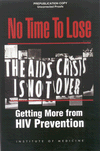Report Calls for
Science-Based
Efforts to Prevent HIV’s
Spread
Validates amfAR’s Long-Standing
Prevention Strategy

On September 27, the Institute of
Medicine (IOM) of the National Academy of Sciences issued a
much anticipated blueprint for future HIV/AIDS prevention
efforts. Titled "No Time To Lose: Getting More from HIV
Prevention," the report was authored by the IOM’s Committee on
HIV Prevention Strategies in the United States, which includes
leading prevention experts and is chaired by Harvey V.
Fineberg, M.D., M.P.P., Ph.D., Provost of Harvard University.
The study was sponsored by the U.S. Centers for Disease
Control and Prevention (CDC).
The scientists were unsparing in
their evaluation of current U.S. prevention efforts. As Dr.
Fineberg observed, "The number of new infections remains
unacceptably high [and] new AIDS cases have increased
considerably among women, minority populations, and young
people. Although new AIDS cases have declined among men who
have sex with men, some metropolitan areas are seeing an
increase in HIV infection rates [among] this population. While
new antiretroviral therapies have improved the health and
prolonged the lives of those who are infected, these drugs
also have contributed to a dangerous sense of
complacency."
In drawing up a prevention plan,
the committee adopted the goal of averting as many new HIV
infections as possible using the resources currently
available. Unfortunately, it was found that current public
health strategies are neither cost-effective nor deliver
prevention information and services to those at the greatest
risk of HIV. To redress these and other problems, the
committee articulated the following key
strategies:
- Improved epidemiological
surveillance
: Current
surveillance focuses primarily on reported AIDS cases, but
AIDS diagnosis in the U.S. lags approximately 10 years
behind HIV infection. Thus, the current surveillance system
shows where HIV has been, not where it is now or where it is
going. In order to accurately assess HIV’s impact, the
committee recommends the use of "sentinel" surveys to
monitor specific locations and sub-populations, e.g.,
drug users in treatment, people attending sexually
transmitted disease clinics, etc., using tests that can
indicate recent HIV infections.
Improved allocation of
prevention resources:
Most prevention funds are currently allocated according to
the number of reported AIDS cases in specific populations or
regions. As noted above, however, AIDS prevalence does not
reflect current prevention needs. The committee recommends
directing prevention efforts to populations at high risk of
infection, and using interventions of proven efficacy and
cost-effectiveness, which could prevent 20% to 30% more
infections than the current allocation of HIV prevention
funds.
Improved prevention services for
those who are HIV-infected: People with HIV/AIDS should be more consistently
educated and encouraged to protect others. In addition, many
individuals at high risk for HIV infection come into contact
with the health care system, and prevention outreach for
such individuals should be integrated into the clinical
setting.
Improve effectiveness of
community-based prevention programs: There are a variety of community-based
programs that provide prevention education. In order to
identify which are most cost-effective, we need to evaluate
them scientifically and then translate the results of such
studies into concrete recommendations.
Develop vaccines and
microbicides: The report
recommends that the National Institutes of Health place high
priority on the development of anti-HIV microbicides and
vaccines and that funding be increased accordingly.
Overcome social barriers to
effective policy: Social
and cultural attitudes towards sexual activity and drug use
have tended to foster shortsighted policies, such as
insufficient funding for drug abuse treatment, limited
access to sterile syringes, and requirements that public
funds be used for "abstinence only" education, which impede
the implementation of proven HIV prevention
interventions.
The overarching theme of the
committee’s recommendations is that HIV/AIDS prevention policy
should be based on sound scientific principles and seek to
protect everyone at risk of HIV infection. amfAR was among the
very first national organizations to articulate and promote
such a comprehensive science-based prevention philosophy and
continues to advocate an effective national prevention
strategy, which would include removal of the current ban on
federal funding for syringe exchange programs and reform of
existing laws regarding the possession and sale of syringes.
Copies of the IOM’s report are available online; to view, click here.

|